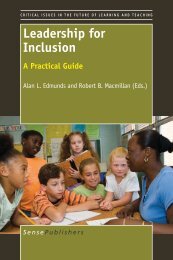1177-threshold-concepts-and-transformational-learning
1177-threshold-concepts-and-transformational-learning
1177-threshold-concepts-and-transformational-learning
- No tags were found...
You also want an ePaper? Increase the reach of your titles
YUMPU automatically turns print PDFs into web optimized ePapers that Google loves.
LAND ET ALvariations arising from the sundry disciplinary contexts of <strong>learning</strong>, or from‘individual inadequacies’. Her analysis leads to a significant contrast in how wemight define <strong>transformational</strong> <strong>learning</strong> as distinct from deep <strong>learning</strong>. As a result ofdeep ‘cumulative’ <strong>learning</strong>, she argues:one switches dynamically – within the same field of consciousness – amongthematic foci, with correspondent restructuring of thematic fields (Booth,1997, p. 144). The total set of elements in the field remains constant, whileboundaries among the thematic foci, the thematic field, <strong>and</strong> the marginbecome fluid; <strong>and</strong> component elements shift between adjacent domains. Themechanism of dynamic switching among extant elements corresponds toreflection; the operation corresponds to refinement <strong>and</strong> clarification of one’sextant meaning frame. (Editors’ italics).In contrast, the outcome of transformative <strong>learning</strong>, she contends, is that:the contents of the field of consciousness change. Elements formerly notfound in any domain of consciousness, possibly including component parts ofelements formerly classified as non-decomposable, now occupy the thematicfocus or reside in the thematic field; <strong>and</strong> some elements formerly found thereare now relegated to the margin. The mechanism remains mysterious <strong>and</strong>corresponds to reflectiveness; the operation, which results in a differentpopulation in the field of consciousness, corresponds to reformulation of one’smeaning frame. (Editors’ italics).In clarifying this nice distinction, she questions whether the proponents of<strong>threshold</strong> <strong>concepts</strong> in their teaching are adopting the latter approach, bringing newmeaning to bear upon existing experience (which the Meyer <strong>and</strong> L<strong>and</strong> frameworkwould seem to condone), or the former approach, which would seem to beattempting the reverse.The nature of troublesome knowledge is given a further dimension in AidanRicketts’ application of the <strong>threshold</strong> <strong>concepts</strong> framework to the teaching of Law(Chapter 3). In relation to <strong>transformational</strong> <strong>learning</strong> he points out that ‘transformativeexperiences may enhance a student’s critical awareness, but this shouldnot be assumed; in some cases the nature of the transformation may actually reducethe scope for critical thinking’. He coins the term ‘loaded knowledge’ to refer tothe manner in which increased access to <strong>and</strong> facility with the ways of thinking <strong>and</strong>practising of a given community of practice (in this case the legal profession) mayhave a reductive effect more generally in terms of occluding other forms ofknowing. The particular instance given here is the way in which students of legaleducation might find access to certain forms of critical knowing difficult withintheir curriculum. This is not inevitable but the practice of legal education needs tobe carefully designed, he argues, to ensure the inclusion of critical perspectives,including critique of ‘the very discipline they have come to study’. In a study ofmuch wider applicability to all disciplines he concludes that it ‘appears inevitablethat studying law will involve encounters with troublesome <strong>and</strong> counter intuitiveideas <strong>and</strong> with loaded knowledge <strong>and</strong> that one way or another law students arexvi




